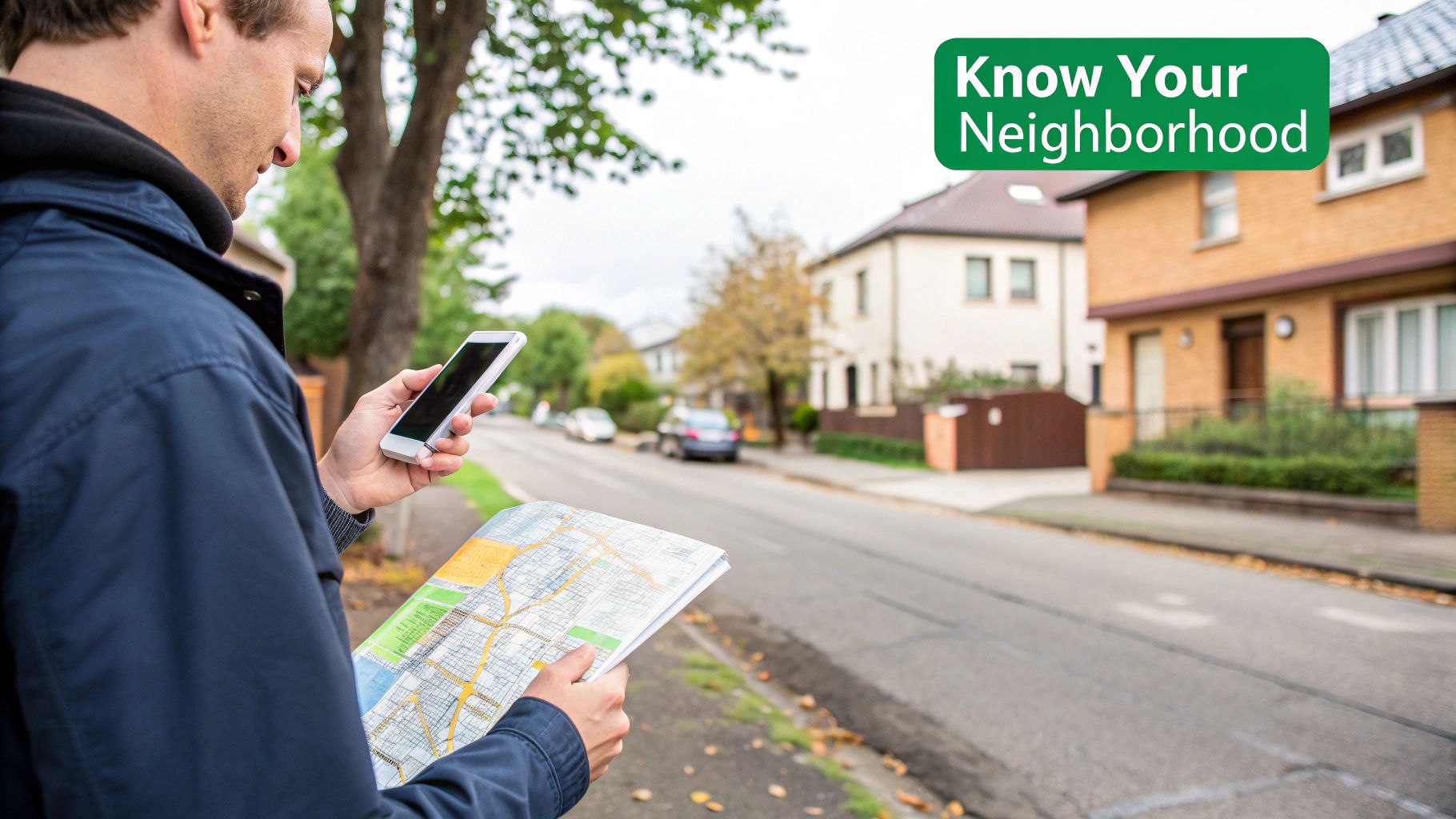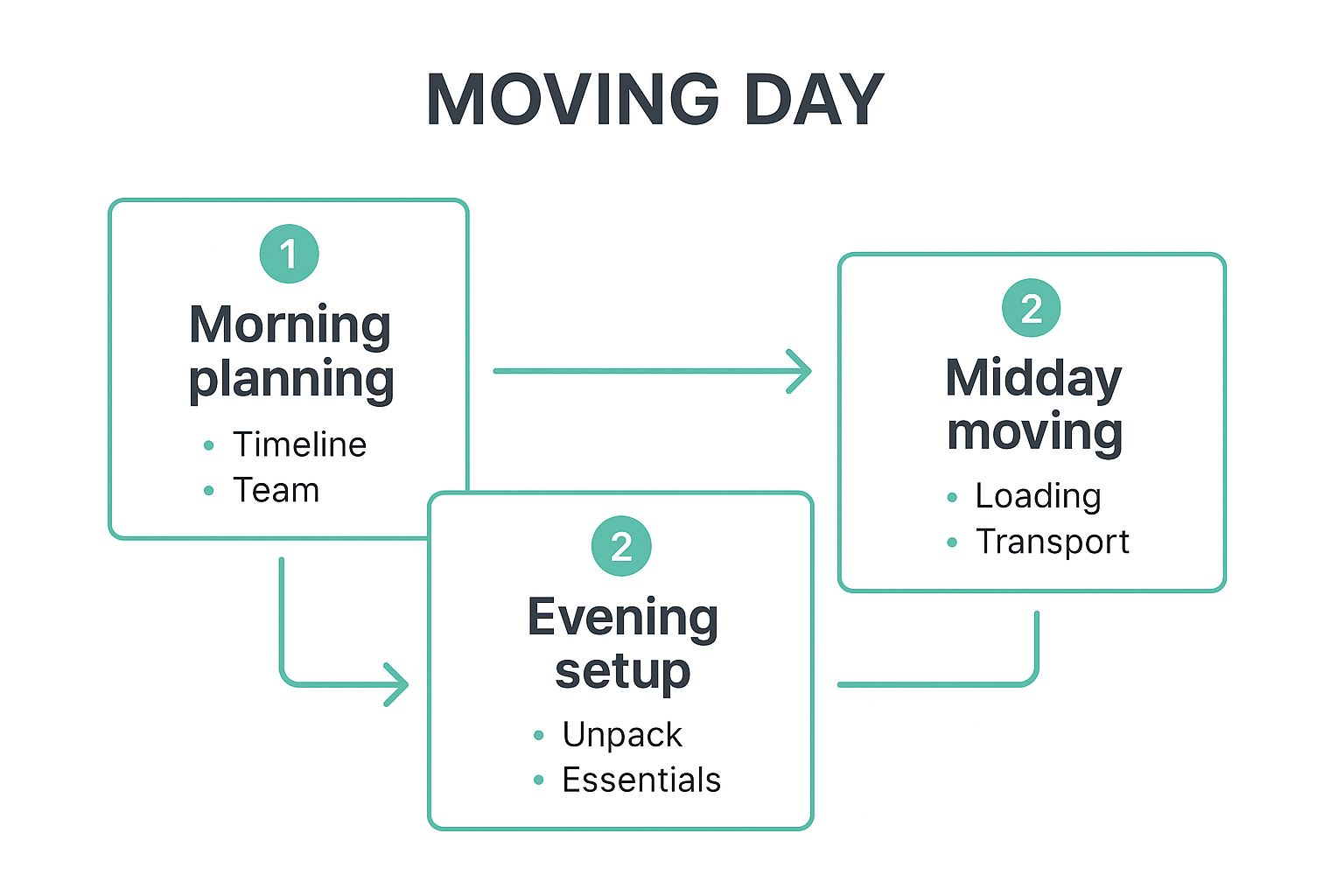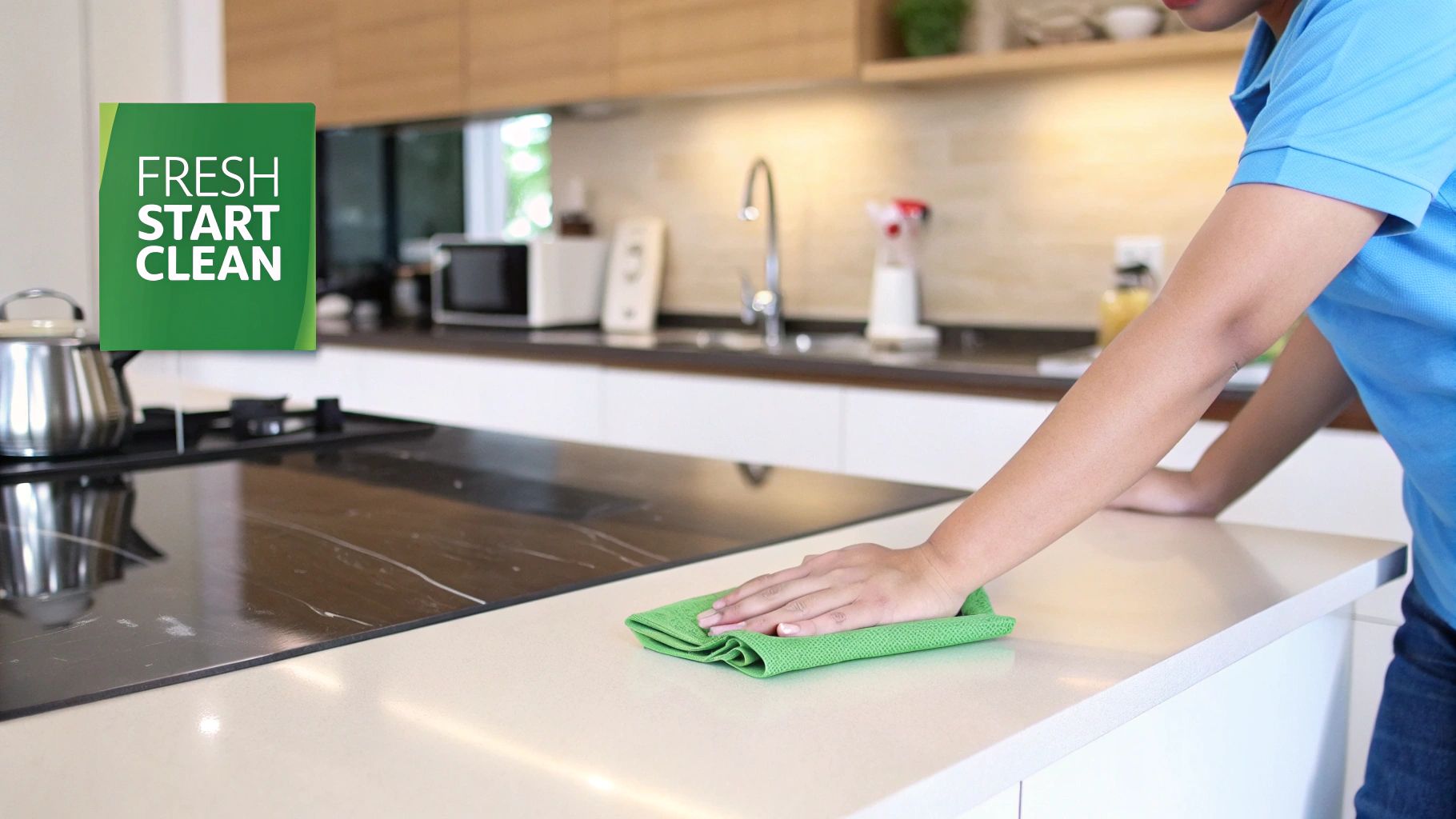Moving into a new house is a monumental step, marking the beginning of a fresh chapter. While exciting, the process can quickly become overwhelming with a whirlwind of tasks, from administrative duties to the physical logistics of the move itself. Staying organised is the key to ensuring a smooth and stress-free transition, allowing you to focus on the joy of a new beginning rather than the chaos of forgotten details.
This guide provides a comprehensive moving into a new house checklist, designed to walk you through every critical stage. We have broken down the entire process into manageable, actionable steps, ensuring nothing gets overlooked. You will find a detailed plan covering everything from the essential pre-move preparations, like setting up utilities and changing your address, to the crucial tasks for moving day and the first few weeks of settling in. Think of this as your master plan for a seamless relocation.
We'll cover the practicalities of packing strategically, deep cleaning your new space before the furniture arrives, and handling important paperwork like updating your driver's licence and insurance. By following this checklist, you can methodically tick off each task, transforming a daunting challenge into a well-managed project. Let's dive into the essential steps to make your move a resounding success.
1. Two Months Out: Strategic Planning and Research
The secret to a stress-free move is starting well before you even think about packing tape. Two months out is the ideal time for strategic planning, laying the essential groundwork for a smooth transition. This phase isn't about physical labour; it's about organising the logistics, finances, and key services that will define your move.
Key Actions for This Phase
Your primary goal is to book major services and begin sorting your life into "keep," "donate," and "discard" piles. Start by researching and obtaining quotes from reputable removalists, as the best ones are often booked weeks or months in advance, especially during peak seasons. Use this time to create a master moving binder or a digital folder (like in Google Drive) to store quotes, receipts, and important documents.
Begin a systematic declutter of your current home, room by room. This not only reduces the volume of items you need to move but can also generate extra cash if you decide to sell things.
Pro Tip: When decluttering, use the "one-touch" rule. Pick up an item and immediately decide its fate: keep, sell, donate, or bin. Avoid creating a "maybe" pile that just delays the decision.
Finally, this is the perfect time to think about the safety of your new home. Researching how to secure your property before you even arrive is a crucial part of any comprehensive moving into a new house checklist. Start by reviewing a comprehensive security audit checklist to understand what you'll need to check, like locks, windows, and alarm systems, on day one.
2. Set Up Utilities and Internet
Walking into your new house only to find the lights don't work and you have no Wi-Fi is a scenario to avoid at all costs. Organising your essential services ahead of time is a non-negotiable part of any moving into a new house checklist. This step ensures your home is liveable and connected from day one, allowing you to focus on unpacking rather than scrambling to get the power on.
Key Actions for This Phase
Your primary task is to contact all necessary utility providers at least two to three weeks before your move-in date. This includes electricity, gas, water, sewerage, and rubbish collection. You'll need to schedule a disconnection date for your old property and a connection date for your new one. For services like internet and pay TV, book an installation appointment for as soon as possible after you move in, ideally the next day, to minimise downtime.
Compile a list of all providers in your new area and compare plans if you have a choice, especially for electricity and internet. Keep all confirmation numbers, account details, and appointment times organised in your moving binder or digital folder.
Pro Tip: On moving day, take a photo of the electricity, gas, and water meters at both your old and new properties. This creates a time-stamped record of the final readings, which can be invaluable for ensuring accurate billing and preventing disputes with previous or future occupants.
3. Transfer Medical and School Records
Amidst the chaos of packing boxes and booking removalists, it’s easy to overlook the critical administrative tasks that ensure a seamless transition for your family's health and education. Transferring medical, dental, veterinary, and school records is a vital step in any moving into a new house checklist, guaranteeing continuity of care and preventing stressful delays when you arrive in your new community. This process involves more than just collecting papers; it’s about proactively managing your family’s wellbeing.
Key Actions for This Phase
Your primary goal is to ensure that new healthcare providers and schools have all necessary information before you need their services. Start by formally requesting records from your current family doctor, specialists, dentist, and veterinarian at least three to four weeks before your move. For children, contact their current school to obtain official transcripts, attendance records, and immunisation histories, which are often required for enrolment in a new district.
Keep both physical and digital copies of all transferred documents in a secure, clearly labelled folder. This personal file acts as a crucial backup. As you gather records, begin researching and contacting new providers in your destination area to confirm they are accepting new patients and are covered by your insurance.
Pro Tip: When you contact new clinics or schools, ask specifically about their transfer process. Many modern practices and school districts use electronic systems (like Epic or Cerner) that can streamline the transfer directly, saving you time and paperwork. Always verify that the records have been successfully received by the new institution before you cancel your services with the old one.
4. Research Your New Neighborhood
A successful move extends beyond the four walls of your new house; it involves integrating into a new community. Researching your new neighbourhood well in advance transforms the unfamiliar into the familiar, making the transition smoother and helping you feel at home faster. This stage is about discovering the local lifestyle, services, and resources that will become part of your daily routine.

Key Actions for This Phase
Your primary goal is to gather practical intelligence that will simplify your first few weeks. Start by joining local online communities like neighbourhood Facebook groups or the Nextdoor app to ask questions and get candid recommendations from future neighbours on everything from the best local takeaway to reliable tradies. Digital reconnaissance is a key part of any modern moving into a new house checklist.
Scout the area in person at different times. A visit during a weekday morning reveals traffic patterns and the school-run rush, while a weekend afternoon shows the community's recreational vibe. Locate essential services like the nearest 24-hour pharmacy, GP clinic, and supermarket. For families, researching local school catchments and ratings is a critical step.
Pro Tip: Create a custom Google Map for your new area. Pin locations for your go-to grocery store, vet, post office, library, parks, and potential new favourite cafes. This visual guide will be invaluable during your first few disorienting days.
Finally, check council websites for information on bin collection days, local regulations, and community events. Understanding these small but crucial details beforehand prevents minor annoyances from piling up, allowing you to settle in and start enjoying your new surroundings immediately.
5. Update Insurance Policies
An often-overlooked but critical part of any moving into a new house checklist is managing your insurance. Moving isn't just about changing your physical address; it's about updating the financial safety nets that protect your life and assets. Your new location can significantly alter your insurance needs and premiums, from home and contents to your vehicle and health cover.
Key Actions for This Phase
Your main objective is to ensure you have continuous and appropriate coverage from the moment you take possession of your new property. Contact your insurance providers at least two to three weeks before your move date to inform them of your change of address. This is the perfect time to review your current policies. For example, your new home's value, location-specific risks like bushfires or flooding, and different state regulations can all impact your homeowner’s insurance.
Similarly, your car insurance rates may change based on the new postcode's garaging risks and driving conditions. If you're moving interstate, your health insurance provider network might not be available, requiring a switch. Bundling home, contents, and car insurance with one provider in your new area can often lead to significant discounts, so getting multiple quotes is a smart financial move.
Pro Tip: Before you start packing, create a detailed photographic or video inventory of your valuable possessions. This documentation is invaluable for verifying your contents insurance claim if items are damaged or lost during the move.
Ensuring your policies are updated and active before moving day is non-negotiable for a secure transition. You can dive deeper into the specifics by reading these essential insurance tips for a stress-free move to fully understand your obligations and options.
6. Create a Moving Day Plan
A successful moving day doesn't happen by chance; it’s the result of a meticulously crafted plan. Moving day is the culmination of all your preparation, and without a clear strategy, it can quickly descend into chaos. A detailed plan acts as your roadmap, guiding everyone involved, from family members to professional removalists, ensuring every action is coordinated and efficient.
Key Actions for This Phase
Your primary goal is to develop a comprehensive timeline and logistical brief for the day itself. Start by creating an hour-by-hour schedule, from an early morning start to the final box being moved in. Assign specific responsibilities to each person helping you, such as who is in charge of directing the removalists, who will watch the children or pets, and who will do the final sweep of the old property.
Prepare a "first night" box for each family member containing essentials like toiletries, a change of clothes, medications, and chargers. Also, assemble an "essentials" box for the house with tools, cleaning supplies, paper towels, and snacks. This is a critical part of any moving into a new house checklist, as it prevents frantic searching for necessities upon arrival.
Pro Tip: Keep a folder with all critical documents, including the removalist contract, new house keys, and important contacts, with you personally. Do not pack this folder in a box. Confirm all arrangements with your removalists 48 hours beforehand.
This infographic outlines a simple, three-step workflow to structure your moving day.

This process flow highlights the importance of transitioning from morning planning and team coordination to the physical labour of moving, and finally to prioritising essential setup tasks in the evening for a comfortable first night.
7. Pack Strategically and Label Boxes
Strategic packing is the difference between a chaotic unpacking process and a seamless transition into your new home. This phase moves beyond simply putting items in boxes; it involves a systematic approach to organising, protecting, and labelling your belongings to ensure they arrive safely and can be found easily. It’s a crucial part of any comprehensive moving into a new house checklist.

Key Actions for This Phase
Your main goal is to protect your possessions while making unpacking efficient. Begin by implementing a clear labelling system, such as using colour-coded tape or stickers for each room (e.g., blue for the kitchen, red for the main bedroom). On each box, list the general contents and the destination room. For added organisation, number each box and maintain a master inventory list that details the contents of each numbered box.
Pack essentials for the first 24 hours in a clearly marked "Open First" box for each key area, like the bathroom and kitchen. This box should contain items you'll need immediately, such as toiletries, a kettle, coffee, snacks, basic tools, and cleaning supplies. Learning how to pack for movers professionally can save you significant time and prevent damage to your items.
Pro Tip: Pack heavy items like books in small boxes and light items like linens in large boxes. This prevents boxes from becoming too heavy to lift safely and reduces the risk of them breaking during transit.
Finally, take photos of the back of your electronics before you disconnect the cables. This simple step creates a visual guide that makes reconnecting your television, computer, and sound system a much faster and less frustrating task.
8. Update Vehicle Registration and Driver's Licence
Amidst the chaos of unpacking, it's easy to overlook crucial administrative tasks, but updating your official documents should be a high priority. Handling your vehicle registration, driver's licence, and voter registration promptly ensures you remain legally compliant in your new state or territory. Neglecting these updates can lead to fines, lapsed insurance coverage, or missing out on important civic duties.
Key Actions for This Phase
Your main objective is to align your personal and vehicle details with your new residential address according to local regulations. For interstate moves, this often involves a strict timeline; for example, some states require you to transfer your licence and registration within 14 or 30 days of establishing residency. Start by visiting the website for your state's transport and main roads department to understand the specific requirements, necessary documents, and associated fees.
Simultaneously, you should update your details on the electoral roll. This is a vital part of any moving into a new house checklist, as it ensures you are registered to vote in your correct local, state, and federal electorates. Often, this can be done at the same time you update your licence.
Pro Tip: Before visiting a service centre, create a dedicated folder with all required documentation. This typically includes multiple forms of identification, proof of your new address (like a utility bill or lease agreement), and your current licence and registration papers. Making an appointment online can save you hours of waiting time.
9. Set Up New Bank Accounts and Financial Services
Moving your belongings is only half the battle; relocating your financial life is just as crucial for a seamless transition. Establishing new banking relationships in your area, or ensuring your existing ones are accessible, prevents disruptions to your cash flow and access to funds. This step is a vital part of any moving into a new house checklist, as it affects everything from paying your first mortgage bill to setting up direct debits for local services.
Key Actions for This Phase
Your primary goal is to ensure continuous and convenient access to your money. If you are moving to a new city or state where your current bank has no branches, start researching local banks and credit unions ahead of time. Compare their fees, interest rates, and services to find one that suits your needs. For instance, you might open a new account with a local credit union for better loan rates while keeping your national online bank for its high-yield savings.
Once you have chosen, begin the process of opening new accounts and transferring funds. It is wise to keep your old account open for a short period after the move to catch any forgotten automatic payments or final direct deposits. Make a comprehensive list of all services linked to your old account-like your salary, subscriptions, and bill payments-and methodically update them with your new banking details.
Pro Tip: When switching banks, ask about any new customer or relocation bonuses. Some financial institutions offer cash incentives or preferential rates for new clients, which can provide a welcome financial boost during an expensive move.
10. Deep Clean and Inspect Your New Home
The small window of time when your new house is completely empty is a golden opportunity. Before a single box crosses the threshold, conducting a deep clean and a thorough inspection is essential. This step ensures you start life in your new space in a pristine, sanitary environment and allows you to identify and document any pre-existing issues without furniture or belongings in the way.

Key Actions for This Phase
Your primary focus is to address every nook and cranny. Start with areas that will be difficult to access later, like the insides of cabinets, pantry shelves, and behind large appliances. This is the ideal time to hire professional services for tasks like steam cleaning carpets or cleaning air ducts to remove dust and allergens left by previous occupants.
Concurrently, perform a detailed inspection. Test every electrical outlet, light switch, and plumbing fixture. Check the water pressure in showers and taps, and run the heating and cooling systems to ensure they function correctly. Document any scuffs on the walls, chips in tiles, or other minor damages. This inspection is a crucial part of any comprehensive moving into a new house checklist, providing you with a clear record of the property's condition upon your arrival.
Pro Tip: Create a "first-day" cleaning kit with all-purpose spray, cloths, paper towels, rubbish bags, and a vacuum cleaner. Keep this separate from your main packed supplies so you can tackle immediate cleaning tasks as soon as you get the keys.
New Home Move-In Checklist Comparison
| Item | Implementation Complexity 🔄 | Resource Requirements ⚡ | Expected Outcomes 📊 | Ideal Use Cases 💡 | Key Advantages ⭐ |
|---|---|---|---|---|---|
| Change Your Address | Moderate – involves multiple institutions | Time for forms and confirmations; small USPS forwarding fee | Continuity of mail and services; legal compliance | Moving residences requiring official address updates | Prevents missed mail; reduces identity theft risk |
| Set Up Utilities and Internet | Moderate – scheduling and coordination | Setup fees ($25-100/service); deposits; installation appointments | Immediate home comfort and functionality | New home move-in requiring essential services | Ensures service continuity; bundling saves money |
| Transfer Medical and School Records | High – involves multiple providers | Time-intensive; possible fees; records retrieval | Continuity of care and education; legal compliance | Families/pets needing care and school enrollment | Prevents delays; maintains treatment history |
| Research Your New Neighborhood | Low to Moderate – mainly research | Time investment; use of apps and websites | Informed decision-making; faster community integration | New residents assessing area suitability | Identifies services and safety; reveals local options |
| Update Insurance Policies | Moderate – requires policy review & updates | Time for quotes; documentation; possible premium changes | Continuous and location-appropriate coverage | Movers needing to update auto, home, health policies | Potential premium savings; coverage adjustments |
| Create a Moving Day Plan | Moderate – requires detailed planning | Time for coordination; planning tools or apps | Reduced stress; efficient move execution | All moves needing logistical coordination | Minimizes loss/damage; organizes teams effectively |
| Pack Strategically and Label Boxes | Moderate to High – systematic packing | Time and quality packing materials expenses | Faster unpacking; protected belongings | Movers wanting organized and damage-free packing | Speeds unpacking; reduces item damage |
| Update Vehicle Registration and Driver's License | Moderate – legal compliance with deadlines | Fees ($25-150); DMV visits or appointments | Legal compliance; updated voter registration | Interstate movers and new state residents | Avoids fines; enables voter participation |
| Set Up New Bank Accounts and Financial Services | Moderate – account transfers and research | Time for transfers; possible credit checks | Local banking access; financial relationship establishment | Movers relocating to new area needing banking changes | Possible better rates; relocation incentives |
| Deep Clean and Inspect Your New Home | Moderate – cleaning and inspection processes | Cost for professionals ($200-500) or time if DIY | Clean, safe living environment; documented property condition | Moving into new or rental properties | Healthier home; identifies maintenance needs |
Making Your New House a Home
Congratulations, you’ve navigated the complexities of moving and are standing at the threshold of a new chapter. The journey from signing the papers to unlocking your new front door is monumental, and this comprehensive moving into a new house checklist was designed to be your trusted roadmap. By now, you’ve tackled the essential administrative tasks like changing your address and setting up utilities, and you've handled the practical logistics of strategic packing and deep cleaning. These steps aren't just about ticking boxes; they are the foundational actions that pave the way for a smooth, organised, and stress-free transition.
Remember, the goal was never just to move your belongings. It was to move your life. Transferring medical records, updating insurance policies, and researching your new community are crucial for continuity and peace of mind. You've laid the groundwork to not just exist in a new space, but to truly live and thrive in it. This proactive approach prevents the common pitfalls of a chaotic move, such as lost mail, service interruptions, or last-minute panic.
From a Checklist to a Lived-In Sanctuary
Now, the real adventure begins: transforming this structure of walls and rooms into a place that truly feels like your own. The initial days and weeks are a unique opportunity to set the tone for your new life.
- Unpack with Intention: Resist the urge to empty every box in a single weekend. Start with the essentials, like the kitchen and bedrooms, to create functional, comfortable zones first. This measured approach prevents you from feeling overwhelmed and allows you to thoughtfully decide where each item belongs.
- Prioritise Safety and Security: As you settle in, you'll want to ensure your new space feels secure. This might include changing locks, checking smoke detectors, and perhaps considering modern security systems. A great first step is understanding home security system costs to plan your budget effectively and make an informed decision for your family's safety.
- Establish New Routines: Discover your new favourite coffee shop, map out the best route for your morning walk, and find your local grocery store. Building these small, daily rituals helps to quickly replace the feeling of being a visitor with the comfort of being a resident.
- Connect with Your Community: Don't be shy about introducing yourself to your neighbours. A friendly hello can be the start of a supportive local network. Explore local parks, libraries, and community centres to get a real feel for the neighbourhood's character.
Key Takeaway: A successful move is not defined by the speed of unpacking, but by the quality of the foundation you build for your new life. Embrace the process, be patient with yourself, and focus on creating a space that reflects your personality and supports your well-being.
Welcome home.
Ready to make your next move your best one yet? For a seamless, professional, and stress-free relocation experience where every detail is handled with care, trust the experts at Emmanuel Transport. Let us handle the heavy lifting so you can focus on starting your new chapter.













